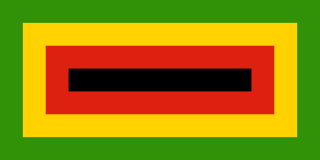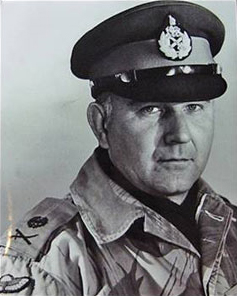
Samora Moisés Machel was a Mozambican military commander and political leader. A socialist in the tradition of Marxism–Leninism, he served as the first President of Mozambique from the country's independence in 1975.

RENAMO is a Mozambican political party and militant group. The party was founded with the active sponsorship of the Rhodesian Central Intelligence Organisation (CIO) in May 1977 from anti-communist dissidents opposed to Mozambique's ruling FRELIMO party. RENAMO was initially led by André Matsangaissa, a former senior official in FRELIMO's armed wing, and was composed of several anti-communist dissident groups which appeared immediately prior to, and shortly following, Mozambican independence. Matsangaissa, who died in 1979, was succeeded by Afonso Dhlakama, who led the organization until he died in 2018. He was succeeded by Ossufo Momade.
The 5th Brigade was an infantry brigade of the Zimbabwe National Army (ZNA). The 5th Brigade was created in 1981 from three former battalions of the Zimbabwe African National Liberation Army (ZANLA). It later incorporated over 3,000 ex-ZANLA guerrillas from various units. The brigade was based in Gweru and participated in the Mozambican Civil War as well as a genocide known as the Gukurahundi which targeted Ndebele civilians and Zimbabwe People's Revolutionary Army (ZIPRA) guerrillas.

The Rhodesian Bush War, also called the Second Chimurenga as well as the Zimbabwean War of Liberation, was a civil conflict from July 1964 to December 1979 in the unrecognised country of Rhodesia.

The Zimbabwe National Army (ZNA) is the primary branch of the Zimbabwe Defence Forces responsible for land-oriented military operations. It is the largest service branch under the Zimbabwean Joint Operations Command (JOC). The modern army has its roots in the Rhodesian Army, which was raised between 1963 and 1964 after the breakup of the Federation of Rhodesia and Nyasaland. A Joint High Command created in March 1980 to oversee integration of the formerly belligerent Rhodesian Security Forces, Zimbabwe African National Liberation Army (ZANLA), and the Zimbabwe People's Revolutionary Army (ZIPRA) officially established the Zimbabwe National Army in late 1980, nearly a year after the end of the Rhodesian Bush War.

Zimbabwe African National Liberation Army (ZANLA) was the military wing of the Zimbabwe African National Union (ZANU), a militant African nationalist organisation that participated in the Rhodesian Bush War against white minority rule of Rhodesia.

The Mozambican Civil War was a civil war fought in Mozambique from 1977 to 1992. Like many regional African conflicts during the late twentieth century, the impetus for the Mozambican Civil War included local dynamics exacerbated greatly by the polarizing effects of Cold War politics. The war was fought between Mozambique's ruling Marxist Mozambique Liberation Front (FRELIMO), the anti-communist insurgent forces of the Mozambican National Resistance (RENAMO), and a number of smaller factions such as the PRM, UNAMO, COREMO, UNIPOMO, and FUMO.

Solomon Mujuru, also known by his nom-de-guerre, Rex Nhongo, was a Zimbabwean military officer and politician who led Robert Mugabe's guerrilla forces during the Rhodesian Bush War. He was an influential figure in Zimbabwe's post-independence politics.
Special Forces of Zimbabwe are the units of the Zimbabwe National Army that operate as special forces. These forces have been deployed in several African conflicts, including the Mozambique Civil War and the Second Congo War.

The military history of Zimbabwe chronicles a vast time period and complex events from the dawn of history until the present time. It covers invasions of native peoples of Africa, encroachment by Europeans, and civil conflict.

Lieutenant General George Peter Walls was a Rhodesian soldier. He served as the Head of the Armed Forces of Rhodesia during the Rhodesian Bush War from 1977 until his exile from the country in 1980.
Engelbert Rugeje is a Zimbabwean politician and retired general officer who is the ZANU-PF national political commissar since December 2017. He was the Chief of Staff of the Zimbabwe National Army (ZNA) until 2007. He was a prominent figure in the 2007 Zimbabwean coup d'état attempt. In December 2017 he was promoted from major general to lieutenant general upon retirement and admitted into ZANU-PF.

The Police Support Unit, also known by their nickname of the Black Boots, is a paramilitary wing of the Zimbabwe Republic Police. They were founded as a native police force but later developed into a counter-insurgency unit of the British South Africa Police in Rhodesia during the Rhodesian Bush War. The unit was the only paramilitary unit retained by the Zimbabwe Republic Police after the country's reconstitution as Zimbabwe.
Zimbabwe National Liberation War Veterans Association (ZNLWVA) is a Zimbabwean organisation established by former guerrillas of the Zimbabwe African National Liberation Army (ZANLA) and Zimbabwe People's Revolutionary Army (ZIPRA) who served during the Rhodesian Bush War. While not considered a state entity, the ZNLWVA is dependent on funding and support from Zimbabwe's ruling party, the Zimbabwe African National Union - Patriotic Front (ZANU-PF). In 2005, the government looked into ways to make members of the organisation part of the army of Zimbabwe.
The Joint Operations Command (JOC) is the supreme organ for the coordination of state security in Zimbabwe. It was established by the Rhodesian Security Forces as Combined Operations Headquarters to supervise its counter-insurgency campaign in the Rhodesian Bush War as well as external incursions into neighbouring countries such as Zambia and Mozambique. The JOC retained its role in the post-independence Zimbabwe Defence Forces, and has since been accused of manipulating elections and orchestrating political violence.
Vitalis Musungwa Gava Zvinavashe was a Zimbabwean general officer, politician and the first commander of the Zimbabwe Defence Forces "ZDF". Zvinavashe had modest academic credentials but was renowned among Zimbabwe’s military circles as a strategist.

The Victoria Falls Conference took place on 26 August 1975 aboard a South African Railways train halfway across the Victoria Falls Bridge on the border between the unrecognised state of Rhodesia and Zambia. It was the culmination of the "détente" policy introduced and championed by B. J. Vorster, the Prime Minister of South Africa, which was then under apartheid and was attempting to improve its relations with the Frontline States to Rhodesia's north, west and east by helping to produce a settlement in Rhodesia. The participants in the conference were a delegation led by the Rhodesian Prime Minister Ian Smith on behalf of his government, and a nationalist delegation attending under the banner of Abel Muzorewa's African National Council (UANC), which for this conference also incorporated delegates from the Zimbabwe African National Union (ZANU), the Zimbabwe African People's Union (ZAPU) and the Front for the Liberation of Zimbabwe (FROLIZI). Vorster and the Zambian President Kenneth Kaunda acted as mediators in the conference, which was held on the border in an attempt to provide a venue both sides would accept as neutral.
The 1981 Entumbane uprising, also known as the Battle of Bulawayo or Entumbane II, occurred between 8 and 12 February 1981 in and around Bulawayo, Zimbabwe amid political tensions in the newly independent state. Zimbabwe People's Revolutionary Army (ZIPRA) guerrillas, mainly in the city's western suburb of Entumbane, rebelled, creating a situation that threatened to develop into a fresh civil war, barely a year after the end of the Bush War. The Rhodesian African Rifles (RAR) and other white-commanded elements of the former Rhodesian Security Forces, fighting for the Zimbabwean government as part of the new Zimbabwe National Army, put down the uprising. Groups of Zimbabwe African National Liberation Army (ZANLA) fighters attacked both ZIPRA and the government forces during the revolt, which followed a smaller outbreak of fighting between guerrillas in November 1980.
The Commander of the Zimbabwe Defence Forces is Chief of the Zimbabwe Defence Forces and the national defence organisations.

Operation Quartz was a planned military operation to be conducted by the Rhodesian Security Forces against Robert Mugabe and ZANU-PF in the event that party lost the Southern Rhodesian general election, 1980. The operation was organized on the assumption ZANU-PF would attempt to violently seize the government should it lose the election. ZANU-PF ultimately won the election and Operation Quartz was never executed.












